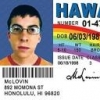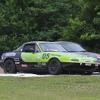What is "Lap Statistics"? Is that some kind of software product?
Nope, sorry I wasn't more clear. A lot of times when we look at data, we look at finer and finer detail. For instance, we'll look at a lap, then a specific corner, then the turn in. This is taking a step back and saying, what if we look at an average (or max or min) from a lap and then compare it to lap time, another measure, or just chart it lap after lap. To make these, I used an AiM logger and exported a channel report that had the average for each lap. I opened that up in Excel and then made the charts.
I've included two more to help explain the idea better. The first shows tires temps and lap time on the Y axis (vertical) and lap number across the bottom. You can see the dip in the lap time matches up to the increase in tire temp. If we build a graph just comparing the tire temps versus lap time you can really see the relationship. This was a pretty cold day, but if you got enough temp into the tire, you would see the higher temps start to give higher lap times as the tire overheats. The same can be done with the tire temps versus lat or long G, grip factors, etc to really see the optimal temps for the tires. Then, if you do similar with tire pressures and other setup measures, you can figure out the optimal setup window for you car.
It's sort of like taking data mining and applying it to race cars!
What are you generating that data from? How are you measuring grip- lateral gs, slip angle, etc?
This is using lateral and longitudinal Gs to develop the numbers. The Grip Factors use specific portions of the Combined G to show how much traction you have in cornering, braking, accelerating, and overall.
This is all laid out in Jorge Seger's book "Analysis Techniques for Racecar Data Acquisition Second Edition." Jorge is a DTM data engineer and share some of the measures and methods that they use to determine the best best car setup, driver analysis, and pre/post event information. It's really a great book. This is it on Amazon http://www.amazon.co...ASIN=0768064597
 Mazda Racer.png 38.65KB
0 downloads
Mazda Racer.png 38.65KB
0 downloads
 Mazda Racer 2.png 18.15KB
0 downloads
Mazda Racer 2.png 18.15KB
0 downloads
 Lap Stats.png 41.16KB
6 downloads
Lap Stats.png 41.16KB
6 downloads lap stats 2.png 14.46KB
3 downloads
lap stats 2.png 14.46KB
3 downloads Grip Factor Radar.png 8.22KB
3 downloads
Grip Factor Radar.png 8.22KB
3 downloads



 Sign In
Sign In Create Account
Create Account





 Back to top
Back to top Report
Report
















